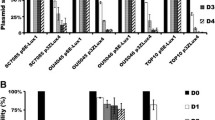Abstract
Purpose
The goal of this study was to develop a plasmid-based lux bio-reporter for use to obtain in vivo images of Brucella suis vaccine strain 2 (B.suis S2) infection with high resolution and good definition.
Procedures
The pBBR-lux (pBBR1MCS-2-lxCDABE) plasmid that carries the luxCDABE operon was introduced into B. suis S2 by electroporation yielding B. suis S2-lux. The spatial and temporal transit of B. suis S2 in mice and guinea pigs was monitored by bioluminescence imaging.
Results
The plasmid pBBR-lux is stable in vivo and does not appear to impact the virulence or growth of bacteria. This sensitive luciferase reporter could represent B. suis S2 survival in real time. B. suis S2 mainly colonized the lungs, liver, spleen, and uterus in mice and guinea pigs as demonstrated by bioluminescence imaging.
Conclusion
The plasmid-based lux bioreporter strategy can be used to obtain high resolution in vivo images of B. suis S2 infection in mice and guinea pigs.






Similar content being viewed by others
References
Foster G, Osterman BS, Godfroid J et al (2007) Brucella ceti sp nov and Brucella pinnipedialis sp nov for Brucella strains with cetaceans and seals as their preferred hosts. Int J Syst Evol Microbiol 57:2688–2693
Scholz HC, Hubalek Z, Sedlacek I et al (2008) Brucella microti sp nov., isolated from the common vole Microtus arvalis. Int J Syst Evol Microbiol. Microbiology 58:375–382
Scholz HC, Nockler K, Gollner C et al (2010) Brucella inopinata sp nov., isolated from a breast implant infection. Int J Syst Evol Microbiol. Microbiology 60:801–808
He YQ (2012) Analyses of Brucella pathogenesis, host immunity, and vaccine targets using systems biology and bioinformatics. Front Cell Infect Microbiol 2:17
Xavier MN, Paixao TA, Poester FP et al (2009) Pathological, immunohistochemical and bacteriological study of tissues and milk of cows and fetuses experimentally infected with Brucella abortus. J Comp Pathol 140:149–157
Corbel MJ (1997) Brucellosis: an overview. Emerg Infect Dis 3:213–221
Doganay M, Aygen B (2003) Human brucellosis: an overview. Elsevier Ltd, pp 173–182
Schurig GG, Sriranganathan N, Corbel MJ (2002) Brucellosis vaccines: past, present and future. Vet Microbiol 90:479–496
Jiang H, Fan MG, Mi JC et al (2013) MLVA genotyping of Brucella melitensis and Brucella abortus isolates from different animal species and humans and identification of Brucella suis vaccine strain S2 from cattle in China. PLoS One 8, e76332
Grillo MJ, Blasco JM, Gorvel JP et al (2012) What have we learned from brucellosis in the mouse model? Vet Res 43:29–29
Close DM, Xu T, Sayler GS, Ripp S (2011) In vivo bioluminescent imaging (BLI): noninvasive visualization and interrogation of biological processes in living animals. Sensors (Basel) 11:180–206
Contag PR, Olomu IN, Stevenson DK, Contag CH (1998) Bioluminescent indicators in living mammals. Nat Med 4:245–247
Close D, Xu T, Smartt A et al (2012) The evolution of the bacterial luciferase gene cassette (lux) as a real-time bioreporter. Sensors (Basel) 12:732–752
Rajashekara G, Glover DA, Banai M et al (2006) Attenuated bioluminescent Brucella melitensis mutants GR019 (virB4), GR024 (galE), and GR026 (BMEI1090-BMEI1091) confer protection in mice. Infect Immun 74:2925–2936
Rajashekara G, Glover DA, Krepps M, Splitter GA (2005) Temporal analysis of pathogenic events in virulent and avirulent Brucella melitensis infections. Cell Microbiol 7:1459–1473
Sun Y, Connor MG, Pennington JM, Lawrenz MB (2012) Development of bioluminescent bioreporters for in vitro and in vivo tracking of Yersinia pestis. PLoS One 7, e47123
Wang X, Li Z, Dong X et al (2015) Development of Bioluminescent Cronobacter sakazakii ATCC 29544 in a Mouse Model. J Food Prot 78:1007–1012
Bosseray N, Plommet M (1990) Brucella suis S2, Brucella melitensis Rev. 1 and Brucella abortus S19 living vaccines: residual virulence and immunity induced against three Brucella species challenge strains in mice. Vaccine 8:462–468
Blasco JM, Marín C, de Jiménez Bagüés MP, Barberán M (1993) Efficacy of Brucella suis strain 2 vaccine against Brucella ovis in rams. Vaccine 11:1291–1294
Pardon P, Marly J (1976) Resistance of Brucella abortus infected mice to intravenous or intraperitoneal Brucella reinfection. Ann Immunol (Paris) 127:57–70
Gonzalez D, Iriarte M, Marin CM et al (2008) Brucellosis vaccines: assessment of Brucella melitensis lipopolysaccharide rough mutants defective in core and O-polysaccharide synthesis and export. PLoS One 3, e2760
Plommet M, Plommet AM (1988) Reactivation of a residual Brucella abortus 19 vaccine infection in mice by a virulent challenge or by injection of brucellin or of Brucella lipopolysaccharide. Ann Rech Vet 19:245–251
Plommet M, Plommet AM (1988) Virulence of Brucella: bacterial growth and decline in mice. Annales de recherches vétérinaires Annals of veterinary research 19:65
Grilló MJ, Bosseray N, Blasco JM (2000) In vitro markers and biological activity in mice of seed lot strains and commercial Brucella melitensis Rev 1 and Brucella abortus B19 vaccines. Biologicals 28:119–127
Acknowledgments
Financial support for this study came from the National Project of Infectious Diseases (contract no. 2012ZX10004-502).
Author information
Authors and Affiliations
Corresponding authors
Ethics declarations
Conflict of Interest
The authors declare they have no conflict of interest.
Additional information
Xiwen Wang and Zhiping Li contributed equally to this work.
Electronic Supplementary Material
Below is the link to the electronic supplementary material.
ESM 1
(PDF 6389 kb)
Rights and permissions
About this article
Cite this article
Wang, X., Li, Z., Li, B. et al. Bioluminescence Imaging of Colonization and Clearance Dynamics of Brucella Suis Vaccine Strain S2 in Mice and Guinea Pigs. Mol Imaging Biol 18, 519–526 (2016). https://doi.org/10.1007/s11307-015-0925-6
Published:
Issue Date:
DOI: https://doi.org/10.1007/s11307-015-0925-6




